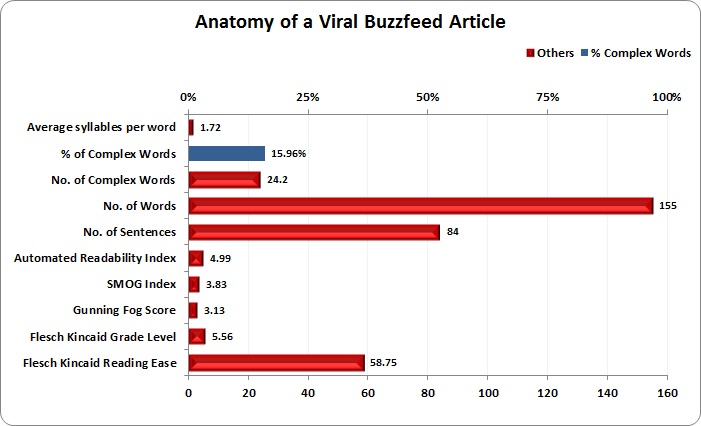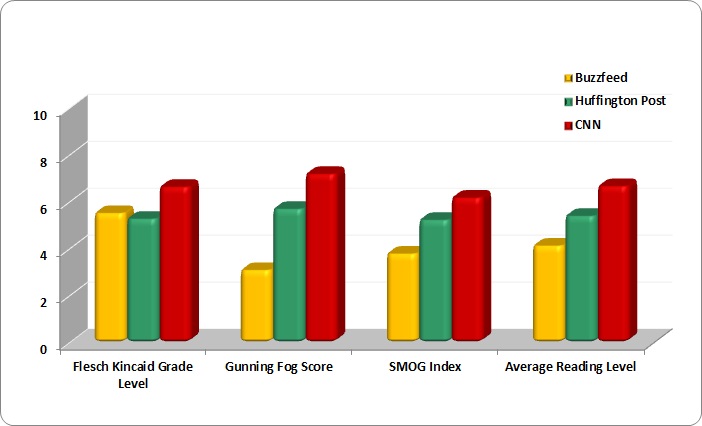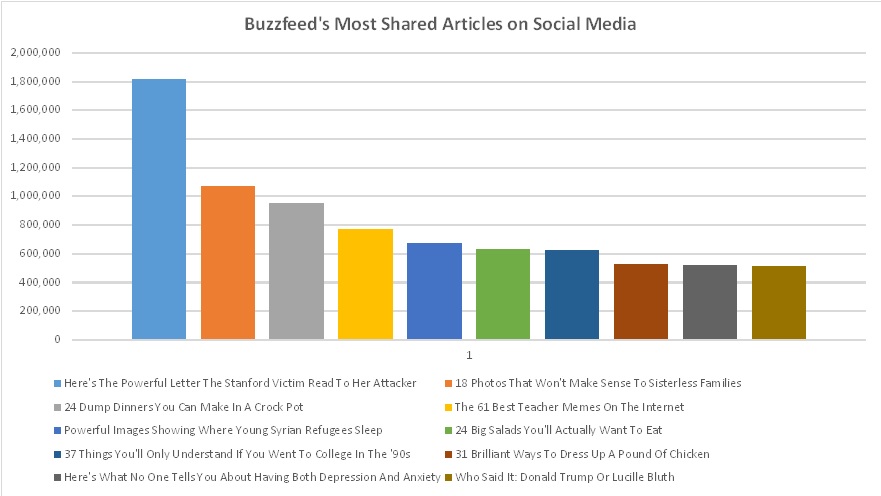Love it or hate it, Buzzfeed is one of the biggest websites in the world. According to Alexa, Buzzfeed is the 47th most popular website in the United States and the 140th most popular site in the entire world. The site gets 7 billion views each month from more than 200 million unique visitors. And despite the company falling well short of its projected revenues in 2015, Buzzfeed is still estimated to be worth $1.5 billion.
The point? Whether you’re someone who is wondering how to start a blog or you’re a seasoned blogger, everyone can learn something from studying how Buzzfeed has built its massive digital empire.
So, just what is the secret to Buzzfeed’s success? Why is it seemingly impossible to get on Facebook, Twitter, or any other social platform without being bombarded by their content?
We decided to take a look at the most popular Buzzfeed articles to see if we could identify the magic formula they use to create viral content. Using BuzzSumo, we were able to identify the 500 most shared (based on total shares across Facebook, Twitter, and LinkedIn) Buzzfeed articles published over the last year. We then analyzed these 500 articles, focusing specifically on their readability (the grade level they were written at), headline style, and length:
- Readability: While Buzzfeed does actually offer some in-depth, quality journalism, the site is widely known for its easy-to-digest “clickbait” style content. Using the Readability Test Tool, we graded the readability for each article using multiple formulas, including Flesch Kincaid Reading Ease and Grade Level, Gunning Fog Score, and SMOG Index. These formulas rely on factors like the percentage of complex words used in an article, average syllables per word, and average words per sentence. By utilizing multiple readability formulas, we feel we were able to get a more accurate assessment of the average reading level of a viral Buzzfeed article.
- Headline style: A great article may never get read if it has a terrible headline. Conversely, a poorly written, even spammy article can get tons of traffic and shares if it has an irresistible, clickbait headline.
- Article length: On one hand, the average first page search result in Google contains 1,890 words. On the other hand, humans now have a shorter attention span than goldfish. Many people simply don’t have the patience to read long-form content on the web. By looking at the average word and sentence count of Buzzfeed’s most popular articles, we’re able to see which approach they’ve had more success with.
Key Findings

The average Buzzfeed article is written at a 4th grade reading level.
Despite its push in recent years to move beyond listicles featuring cute cat pictures and 90s nostalgia and into legitimate journalism, Buzzfeed’s most popular articles are still mostly written at a level that a 9-year-old can easily understand them. The top 500 shared articles achieved average scores of 5.56 Flesch Kincaid Grade Level, 3.13 Gunning Fog, and 3.83 SMOG Index — averaging out to a 4th grade reading level.
For comparison sake, we also ran the top 500 articles from Huffington Post and CNN through these same tests. We chose these two sites because Huffington Post does a balance of traditional journalism along with the clickbait Buzzfeed is known for, while CNN is an example of a site that focuses exclusively on “real” journalism.
Here’s how Buzzfeed stacked up against those sites:

As expected, both Huffington Post and CNN are written at a higher average reading level than Buzzfeed. But the sites have different audiences and different types of content. Saying that Buzzfeed articles are written at a 4th grade level while CNN’s are written at a 7th grade level isn’t meant to be a cheap shot at Buzzfeed.
The lesson here is that you have to know who your audience is, what they’re looking for, and how to adapt your blog ideas and content to best appeal to them. Buzzfeed wants its content to be easy to read and enjoy for a diverse audience across all ages, so it makes sense to keep the language simple.
As a blogger, your job is to communicate with your target audience in a way that best resonates with them. That might mean writing at a 4th grade reading level or at a college reading level. It’s up to you to know your audience.
65% of Buzzfeed’s viral articles are listicles.
From 18 Photos That Won’t Make Sense to Sisterless Families to 34 Unforgettable Back-To-School Things All ’90s Teenage Girls Did, the listicle is still the most common type of Buzzfeed article. List posts are inherently shareable and are typically quick and easy to read or scan over. Even within Buzzfeed’s 10 most shared articles over the last year, you can see how dominant the listicle is, accounting for 6 of them.

Now, does that mean that every article you write needs to be a top 10 list? Does it mean that listicles are the magic bullet for viral success? Of course not. But it does serve as a reminder that catchy headlines get clicks and easily scannable content is ideal for the web.
If you want to write better headlines to give your content the best chance of getting noticed, I highly recommend using the free Blog Post Headline Analyzer tool that CoSchedule offers. You can put your headline in the tool and it will provide instant analysis on how share-worthy and SEO-friendly it is, so you can get more clicks.
The average headline length of a Buzzfeed article is 10.47 words and 59.28 characters.
Headline length is something marketers have always debated. Is there an ideal headline length? If so, what is it?
While this Kissmetrics article states that the “perfect length for a headline” is 6 words, this Hubspot report claims the ideal headline length to be between 8-12 words and under 70 characters. The truth is nobody really knows the answer, and as with everything else, it all depends on the audience.
At Buzzfeed, the average headline of a viral post is right around 10 words and just under 60 characters.
There is some importance to those numbers. At 59 characters, the title won’t get cut off in search engine results (Google typically cuts off titles that are longer than 70 characters) and won’t exceed Twitter’s character limits when shared.
Ideally, you should be testing out different headline lengths to see what generates the most clickthroughs and shares with your particular audience.
Buzzfeed keeps its articles short and easy to read.
The average Buzzfeed article we analyzed was just 155 words long. To put that into context, the average 3rd grade student can read 150 words per minute. An 8th grade student can read 250 words per minute. In other words, Buzzfeed’s articles are designed so you can read them quickly and easily, share them, and get on with your life. They’re often heavy on the images and gifs and light on written content.
Again, this doesn’t necessarily mean that short-form content is the only way to attract an audience or score a viral hit. For the fun, humorous, light stories that Buzzfeed is most known for, short-form content makes sense. After all, a 5,000 word article that takes 20 minutes to read on the funniest times a cat was doing cat things probably wouldn’t get read by that many people (except maybe those over at /r/cats on Reddit).
But not every site is like Buzzfeed. Your blog might be focused on being a thought leader, providing data-driven articles and in-depth analysis to educate readers. In those cases, a 155 word article like Buzzfeed does wouldn’t make sense. Long-form content would likely be best for getting your message across effectively.
It’s not length alone that matters. It’s about the purpose of the content you’re creating, the value you’re delivering, and the wants of your audience.
Conclusion
It’s hard to argue against the success Buzzfeed has achieved. They clearly have a formula they follow that helps their articles get more social media shares, more traffic, and more buzz. Every blogger can benefit by studying what it is that Buzzfeed does so well and apply any applicable takeaways to their own work.
However, as we pointed out multiple times throughout, there isn’t a one-size-fits-all approach to creating great content that people love. It’s about truly understanding who your audience is and what they want, and delivering it to them in a truly memorable way that demands their attention.

So. Here’s an irony. The oft quoted ‘… humans now have a shorter attention span than goldfish. ” rarely includes a citation and when it does, that article has no published data!!!! Nope. Not in a peer reviewed scientific publication.
If you locate the data, post it! I am curious to know HOW attention span is measured ….my personal experience with goldfish is that they tune out irrelvant-to-them information. Humans now screen out more and more, particularly as the info ‘goes deep’. The less human humans become, the less need to attend in depth. It’s all cotton candy fluff.
Nice article very interesting
Axes labels? Are you at the 4th grade math level?
Haha I was thinking this when I was reading!
I am a successful business entrepreneur and use the internet on my computer most days for articles/business resources etc and I have l never heard of “Buzzfeed”. Seems like a bloody waste of everyone’s time if you ask me.
Funnily enough, I went to school with a guy called Buzz Phede, and he loves all the attention he gets these days! He regularly boasts about how popular he is and jokes to girls about how he’s “gone viral”, although I know for a fact that he’s been single for about nine or ten years now. Great guy!
Character count doesn’t determine truncation in Google search, rather total pixel width.
The author sure puts these findings into practice: 5 out of the 6 articles listed on his website (http://www.ericbrantner.com/articles.html) are listicles. 🙂
Buzzfeed is an excellent website to understand something in the news or media in a fast and easy way. I have used the website before for such things. I didn’t realize that it had this much recognition in the US and around the world though. I think having a headline that’s precise and to the point does help viewers attention. It was interesting to see the statistics on how many words in a headline make it more significant to read. Thank you for letting me understand how Buzzfeed gains such a strong audience. It was definitely worth my time.
Hemmingway wrote at the 4th grade level. Jane Austen wrote at a 5th grade level. Rowlng’s Harry Potter series is 5th grade stuff. Don’t confuse the “level,” of writing with great writing. The great writers write with simplicity and style.
They forgot the social justice warrior mentality that Buzzfeed spews all over the internet
Average article.155 words.84 sentences. Or am I being a goldfish.
This post has given me a new strategy for my 2017 posting plans. buzzfeed are the best when it comes to viral contents and its because of their posts title design. Thanks for let me know the “Blog Post Headline Analyzer tool” as i have tested it in my post too. Obviously this tool will help me in building more titles that will engage with users.
The strategy for writing to 4th grade level is best and i will use this.. Thanks for this wonderful article worth reading.
Yes you’re absolutely right ERIC. BuzzFeed really damn website Nowadays. I just love listicles contents as you already mentioned here as they are Easy-To-Digest. This is why I also do practice by following their content strategy.
Great one Eric.